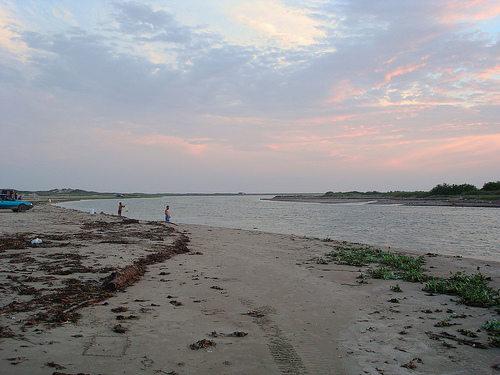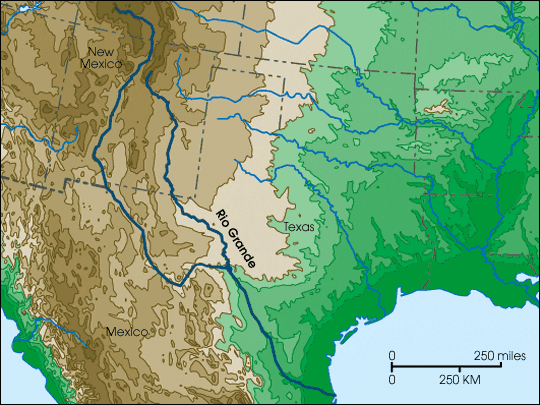|
 The 3,000-km long Rio Bravo, the 5th largest river in North America and 24th largest river in the world, is a major boundary between Mexico and the United States. It is central to the cultural heritage and history of the border region of both countries, with its 467,000 km2 drainage basin stretching across five States in Mexico (Chihuahua, Coahuila, Nuevo Leon, Tamaulipas, Durango) and three States in the USA (Colorado, New Mexico, Texas). The river traverses three major Ecoregions (Southern Rocky Mountains, Chihuahua Desert, and Tamaulipan Thorn Scrub), exhibiting a mosaic of habitats, including riparian forests, mudflats, salt marshes, freshwater springs, and scrublands in mountain, desert and coastal regions. The lower Rio Bravo valley is considered one of the most biologically-diverse regions in the world, with millions of migratory birds stopping to feed and rest there during seasonal migration.
The 3,000-km long Rio Bravo, the 5th largest river in North America and 24th largest river in the world, is a major boundary between Mexico and the United States. It is central to the cultural heritage and history of the border region of both countries, with its 467,000 km2 drainage basin stretching across five States in Mexico (Chihuahua, Coahuila, Nuevo Leon, Tamaulipas, Durango) and three States in the USA (Colorado, New Mexico, Texas). The river traverses three major Ecoregions (Southern Rocky Mountains, Chihuahua Desert, and Tamaulipan Thorn Scrub), exhibiting a mosaic of habitats, including riparian forests, mudflats, salt marshes, freshwater springs, and scrublands in mountain, desert and coastal regions. The lower Rio Bravo valley is considered one of the most biologically-diverse regions in the world, with millions of migratory birds stopping to feed and rest there during seasonal migration.
This international basin is the most rapidly-growing area in both countries; 90% of the border population resides in 14 inter-dependent sister border cities. The annual growth rate in most large basin cities exceeds 3%, with the lower Rio Bravo basin facing a predicted population increase of 175% between 2000 and 2050. There is significant agricultural activity on both sides of the border. The Mexican side of the border has experienced a proliferation of maquiladoras, or assembly plants, associated with the North American Free Trade Agreement (NAFTA), stimulating migration from the interior of the country to the border region. Due to such factors, the Rio Bravo is a river in serious disarray. Although a 1944 Treaty between Mexico and the United States controls the water allocations in the international section of the Rio Bravo, the river's ability to support a formidable range of human physical, social, and economic needs, while also maintaining important ecosystems, is being overwhelmed. Excessive water abstractions (96% of the river's annual average flow has been allocated) are exacerbated by additional factors, including water diversions, dams, high evaporation rates, persistent droughts, invasive species, sensitive terrestrial and aquatic biodiversity, agricultural and urban land use changes, and social dislocations.
 The need to share and utilize the water resources of the transboundary Rio Bravo in a sustainable manner is at the core of this project. Accordingly, this project is directed to developing a comprehensive, participatory framework for the coordinated management of the Rio Bravo basin by its primary water users, particularly to facilitate more efficient water use throughout the basin. The socioeconomic factors influencing the livelihoods of the basin inhabitants, particularly the poor and underrepresented population, are integral to such goals, particularly in regard to maximizing the transboundary benefits. The natural heritage of the Rio Bravo basin also must be considered, being unmatched by any desert river system in the world. Despite its extensive biodiversity, the basin also contains many threatened and endangered species. More than 95% of the lower basin’s native brushland has been converted to agricultural or urban use since the 1920s, and few undisturbed, natural communities remain. Water development projects have seriously disrupted natural flow regimes, affected wetlands and their aquatic fauna, and degraded native riparian plant communities.
The need to share and utilize the water resources of the transboundary Rio Bravo in a sustainable manner is at the core of this project. Accordingly, this project is directed to developing a comprehensive, participatory framework for the coordinated management of the Rio Bravo basin by its primary water users, particularly to facilitate more efficient water use throughout the basin. The socioeconomic factors influencing the livelihoods of the basin inhabitants, particularly the poor and underrepresented population, are integral to such goals, particularly in regard to maximizing the transboundary benefits. The natural heritage of the Rio Bravo basin also must be considered, being unmatched by any desert river system in the world. Despite its extensive biodiversity, the basin also contains many threatened and endangered species. More than 95% of the lower basin’s native brushland has been converted to agricultural or urban use since the 1920s, and few undisturbed, natural communities remain. Water development projects have seriously disrupted natural flow regimes, affected wetlands and their aquatic fauna, and degraded native riparian plant communities.
Against this background, a significant constraint to sustainable use of the Rio Bravo rests on the fact that both countries have treaty obligations to deliver specific quotients of water to each other at different locations in the basin, which seriously complicates the holistic, integrated use of the river. There also is legal and institutional fragmentation of authority for water management in the basin because the waters of the Rio Bravo are governed by a bewildering plethora of binational treaties, interstate compacts, reclamation projects, water rights, and contracts that are, in turn, implemented by a range of governmental agencies at the international, national, State, and local levels. These institutions, and an even larger number of private organizations (e.g. irrigation districts), comprise a large group of different stakeholders that must be involved in transforming the current fragmented system into a more integrated decision making process. Although part of the answer lies in better coordination of activities between organizations on both sides of the border, this goal remains difficult and elusive between the two countries. A lack of effective communication between water-user communities and other stakeholder groups also hinders the goal of sustainable use of the river. Taken together, these factors ensure a continuing piecemeal approach to management of this important transboundary water system.
 Building on the existing legal framework already in place between Mexico and the United States, this project outlines a 2-phased approach of diagnosis and action directed to developing a comprehensive, participatory framework for coordinated management of the Rio Bravo Basin by its stakeholders. This approach is wholly consistent with the Transboundary Diagnostic Analysis (TDA) and Strategic Action Program (SAP) formulation protocols of the Global Environment Facility (GEF) International Waters focal area. The dependency of the Basin's important biological diversity on the condition and sustainability of the Rio Bravo dictates that biodiversity also must be considered within the context of the SAP ultimately developed for the sustainable use of the river. Given the large spatial extent and problems in the Rio Bravo Basin, and the complex social dynamics of the basin inhabitants, achieving these project goals represents a significant, and both environmentally and socially useful, contribution to managing this important transboundary water resource.
Building on the existing legal framework already in place between Mexico and the United States, this project outlines a 2-phased approach of diagnosis and action directed to developing a comprehensive, participatory framework for coordinated management of the Rio Bravo Basin by its stakeholders. This approach is wholly consistent with the Transboundary Diagnostic Analysis (TDA) and Strategic Action Program (SAP) formulation protocols of the Global Environment Facility (GEF) International Waters focal area. The dependency of the Basin's important biological diversity on the condition and sustainability of the Rio Bravo dictates that biodiversity also must be considered within the context of the SAP ultimately developed for the sustainable use of the river. Given the large spatial extent and problems in the Rio Bravo Basin, and the complex social dynamics of the basin inhabitants, achieving these project goals represents a significant, and both environmentally and socially useful, contribution to managing this important transboundary water resource.
The Strategic Plan for partnership for integral development includes the following:
- Improvement of mechanisms for policy dialogue
- Building and strengthening of partnerships
- Capacity-Building
- Resource mobilization
The objectives of Project Rio Bravo are many. The project seeks to (i) contribute to the protection and sustainable use of the water and land resources of the transboundary Rio Bravo Basin within the context of an integrated, ecosystem-based approach to water resources management; (ii) create a binationally-agreed management plan to address the serious human and environmental problems confronting this sensitive transboundary river system, and to maximize its transboundary benefits to the inhabitants of both riparian countries, Mexico and the United States; (iii) protect the biodiversity of the basin in a coordinated, coherent manner; and (iv) promote the coordinated management of the Rio Bravo by participating stakeholders vis-à-vis elaboration of a Strategic Action Program (SAP), so that the basin’s transboundary water resources may be utilized in sustainable manner. The SAP is intended to create the necessary social-economic and policy mechanisms for implementing the agreed action program and engendering the necessary reforms.
The river is called Rio Bravo in Mexico and Rio Grande in the United States.

|